In the context of economic integration and the continuous development of international trade activities, the management of associated transactions has become a challenging issue for most economies, including Vietnam. Therefore, the legal regulations of Vietnam are constructed and adjusted over time to regulate economic relationships, interests between parties, and ensure the interests of the nation. Within the scope of this article, we will explore in detail the legal regulations in Vietnam regarding associated transactions, behaviors considered as transfer pricing, and what relationships are considered associated.

1. Transfer Pricing and Relationships from Associated Transactions
Transfer pricing is a term mentioned in the relationship between parties with associated transactions and is used to explain the actions of enterprises in applying various forms to maximize profits and reduce taxes and financial obligations to the country where the business is operating. In other words, it is the actions of multinational companies to enjoy tax benefits, advantages from differences in tax rates, and legalize money transfer activities under commercial transaction forms that the law does not prohibit to maximize profits.
Transactions between companies with associated relationships are not prohibited by law, and these are normal commercial transactions; however, the factors about prices and favorable conditions recorded in the contract are the things that parties in associated relationships need to pay attention to ensure that the business’s transactions are not considered by the tax authorities as being carried out to cover up for transfer pricing behavior.
In practice, transfer pricing actions are often carried out anonymously through the following commercial transactions:
- Establishing contracts for the purchase of raw materials, provision of services, brokerage, communication… between enterprises with associated relationships, in which the purchase price, service provision, commission… are raised higher than the market. Especially for service contracts, it will be difficult in reality to control whether service provision activities arise between the parties. Another case that is difficult for tax authorities to control is the transfer of goods and services through a third enterprise to hide the associated relationship between the original enterprises.
- Establishing contracts for the transfer of rights to use and ownership of intangible assets, in which the value of intangible assets is pushed up high compared to reality;
- Transferring the payment of high-level personnel costs, operating costs, and overseas training to associated enterprises, and usually these will be enterprises in young, developing economies.
- Establishing loan contracts between enterprises with associated relationships with each other.
One thing that is often seen in enterprises considered to have transfer pricing transactions is that in financial reports, the profit part is quite low or reports continuous losses. To control, the tax administration agency in Vietnam will conduct inspections and audits of the taxpayer’s associated transaction prices according to the independent transaction principle and the nature of operations, and transactions determine tax obligations corresponding to the value created from the nature of transactions, production and business activities of taxpayers, do not recognize associated transactions that do not follow the independent transaction principle that reduces the tax obligations of enterprises to the state budget and carry out adjustments to that associated transaction price to determine the correct tax obligation.
2. When is it Considered to Have an Associated Relationship
(1) According to the regulations of Vietnamese law, enterprises are considered to have an associated relationship when they fall into one of the following cases:
- One party participates directly or indirectly in the management, control, capital contribution, or investment in the other party;
- The parties, directly or indirectly, are subject to the management, control, capital contribution, or investment of another party.
(2) The associated parties in clause 1 of this are specifically regulated as follows:
- An enterprise directly or indirectly holds at least 25% of the owner’s contributed capital of the other enterprise;
- Both enterprises have at least 25% of the owner’s contributed capital held directly or indirectly by a third party;
- An enterprise is the largest shareholder in terms of the owner’s contributed capital and directly or indirectly holds at least 10% of the total shares of the other enterprise;
- An enterprise guarantees or lends to another enterprise under any form (including loans from third parties guaranteed from the financial source of the associated party and financial transactions of a similar nature) with the condition that the loan capital is at least equal to 25% of the owner’s contributed capital of the borrowing enterprise and accounts for over 50% of the total value of the borrowing enterprise’s medium and long-term debts;
- An enterprise appoints a member of the executive board or controls another enterprise with the condition that the number of members appointed by the first enterprise accounts for over 50% of the total number of members of the executive board or controls the second enterprise; or a member appointed by the first enterprise has the right to decide the financial policies or business operations of the second enterprise;
- Two enterprises both have over 50% of the members of the executive board, or both have a member of the executive board who has the right to decide financial policies or business operations appointed by a third party;
- Two enterprises are managed or controlled in terms of personnel, finance, and business operations by individuals in one of the relationships of wife, husband; biological parents, adoptive parents, stepfather, stepmother, parents-in-law; biological children, adopted children, stepchildren of wife or husband, son-in-law, daughter-in-law; siblings of the same parents, siblings of the same father different mother, siblings of the same mother different father, brother-in-law, sister-in-law of the same parents or same father different mother, same mother different father; grandparents; grandchildren; aunts, uncles, and cousins;
- Two business establishments have a relationship of head office and permanent establishment, or both are permanent establishments of a foreign organization or individual;
- Enterprises are controlled by an individual through this individual’s capital contribution to that enterprise or directly participating in the management of the enterprise;
- Other cases in which an enterprise is managed, controlled, and decided in reality on the production and business operations of the other enterprise;
- Enterprises have arising transactions of transfer, receipt of transfer of contributed capital of at least 25% of the owner’s contributed capital of the enterprise in the tax calculation period; borrowing, lending at least 10% of the owner’s contributed capital at the time of transaction arising in the tax calculation period with the individual managing, controlling the enterprise or with an individual in one of the relationships mentioned above.
Adherence to legal regulations not only ensures that associated transactions are conducted in accordance with proper procedures and regulations but also contributes to a healthy business environment where enterprises operate with transparency and accountability. In this context, the construction and maintenance of a robust internal management system aimed at ensuring compliance with legal regulations on associated transactions is of paramount importance. Enterprises need to update and understand new regulations regularly and apply inspection and verification measures to ensure that all transaction activities are within the confines of the law.
Time of writing: 23/08/2023
The article contains general information which is of reference value, in case you want to receive legal opinions on issues you need clarification on, please get in touch with our Lawyer at info@cdlaf.vn

Why choose CDLAF’s service?
- We provide effective and comprehensive legal solutions that help you save money and maintain compliance in your business;
- We continue to monitor your legal matters even after the service is completed and update you when there are any changes in the Vietnamese legal system;
- Our system of forms and processes related to labor and personnel is continuously built and updated and will be provided as soon as the customer requests it;
- As a Vietnamese law firm, we have a thorough understanding of Vietnam’s legal regulations, and grasp the psychology of employees, employers, and working methods at competent authorities;
- CDLAF’s team of lawyers has many years of experience in the field of labor and enterprises, as well as human resources and financial advisory.
- Strict information security procedures throughout the service performance and even after the service is completed.
You can refer for more information:
- 8 important new points regarding Work Permit which take effect from September 18, 2023
- Labor contract or personal consulting service contract
- Termination of the operation of foreign traders’ representative offices
- What should enterprises keep in mind when dismissing employees?
- Conditions that foreign investors must meet when making investments in Vietnam
- Parent company, subsidiaries, and things to note
- The latest regulations on foreign loans in 2023







